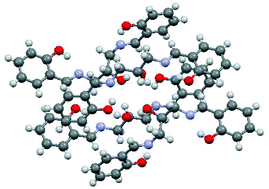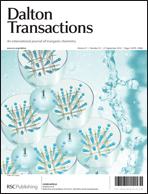Novel Pd(ii)–salen complexes showing high in vitro anti-proliferative effects against human hepatoma cancer by modulating specific regulatory genes†
Abstract
We have reported the synthesis of a novel salen ligand and its mononuclear Pd–salen complexes derived from 2-{[2-hydroxy-3-{[(E)-(2-hydroxyphenyl)methylidene]amino}propyl)imino]methyl}phenol. The newly synthesized and isolated Pd(II) complexes have been identified and fully characterized by various physico-chemical studies viz., elemental analyses, IR, UV-Vis, 1H, 13C NMR spectroscopy, electron spray ionization mass spectrometry (ESI-MS) and TGA/DTA studies. The molecular structure of the salen ligand has been ascertained by single-crystal XRD and it is coordinated to Pd(II) ion through two nitrogen and two oxygen atoms. The UV-Vis data clearly suggest a square-planar environment around both the Pd(II) ions. The DNA binding studies of the synthesized compounds has been investigated by electron spectroscopy and fluorescence measurements. The results suggest that Pd(II) complexes bind to DNA strongly as compared to the free ligand. The free salen ligand and its Pd(II) complexes have also been tested against human hepatoma cancer cell line (Huh7) and results manifested exceptional anti-proliferative effects of the Pd(II) complexes. The anti-proliferative activity of Pd(II) complexes has been modulated by specific regulatory genes.


 Please wait while we load your content...
Please wait while we load your content...